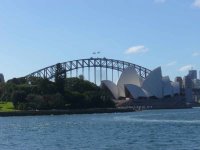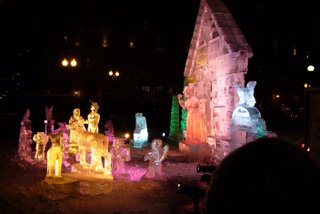
Sydney Opera House Concert Hall. Seat
Program
Concerto in A minor for violin, strings and harpsichord RV356 by Antonio Vivaldi (1678-1742).
Concerto in D major for violin, strings and harpsichord RV230.
Concerto in B flat major for violin, oboe, strings and harpsichord RV548.
Concerto in D major for 2 violins, strings and harpsichord RV507.
Concerto in C major for 2 violins, strings and harpsichord RV511.
Concerto in G minor (Summer from the Four Seaons) for violin, strings and harpsichord RV315.
With the many extra pieces added to the published program, this ended up being a 3 hour concert (including a 25 minute intermission). Nigel Kennedy is a well-known violinist, his Four Seasons CD opened my eyes to new dimensions to Vivaldi’s music, thus I went to the concert with great expectations. Unfortunately, the concert was mostly a series of mediocre performances broken up by moments of brilliance. It was too bad as Kennedy could have chosen to take the concert more seriously rather than indulge in crowd-pleasing antics that detracted from the music.
I arrived in
There is no charitable way to describe Kennedy clothes other than bizarre. One of the coat sleeve is cut short, I guess it at least serve the purpose of not impeding the movement of his right arm. There is also this sash around his neck of unknown significance. I refuse out of principle to purchase a program (for $7.50) that contains mostly advertisements, so if there is an explanation for what he is wearing, it will continue to elude me. To me it’s just an aging artist making a feeble and failed attempt at retaining his youthful looks and outlook. The rest of the orchestra members were dressed more traditionally though. Kennedy also chose to talk to the audience a bit about each piece of music. What he said contained some useful information, but his attempts at humor didn’t work, in my judgment.
Kennedy began by acknowledging tonight was Chinese New Year Eve and played a “new year song” which was actually a communist liberation song. Some Chinese in the audience were appreciative, I found it condescending. It also started my negative view of the concert which was further reinforced by the first Vivaldi piece. The violin concerto in A minor is relatively simple; most violin students take it up during their third year of lessons. It can be enjoyable when brilliantly played. But any flaw will be noticed and greatly magnified. Kennedy’s antics made me wonder whether he chose to put more emphasis on moving around the stage and stomping his boots rather than on playing serious music.
Australian audiences seem to have no problems with applauding in the middle of a work, they demonstrated that after the first movement of the D major violin concerto. I guess that’s okay if it was really exceptional, but doing that as a matter of course is a bit much. How the movements interrelate can be important too. The cadenza for this used similar techniques as that of the first concerto. Even though it was done well, one began to wonder if there are other technical flourishes (harmonics, double stops, etc) that would be displayed tonight.
After this concerto, Kennedy told the audience about the “Manchester Sonatas” that were discovered in the early 1970s. Four movements (Largo/Larghetto, Courant, Gigue, and Gavotte) were played by the violin, harpsichord (basso continuo), guitar, cello and doubling bass. Vivaldi scholars may find the music of great significance, but they didn’t sound particular to me.
Shelfali Pryor was introduced by Kennedy as one of the greatest oboist. Surely he jested. The oboe was overwhelmed by the small orchestra, coming through only during moments when a reduced set of musicians was playing. By this time I was debating whether I should give up on the concert and go home. It was a combination of my desire to stay up to fight jet lag, a stubbornness that makes people finish bad novels, and the fact the ticket cost (Australian) $97 that kept me in my seat.
As an encore piece for the oboe soloist, Kennedy’s own composition “Melody on Wind” was played. It contains a few nice motifs, but they were repeated again and again until the audience was tired of the droning. It is better to leave the audience wanting for more than to make them ask when the piece is going to be put out of its misery. (Not unlike many of my blogs, come to think of it.)
After the intermission, Kennedy added Nos. 1, 8, and 6 of Bach’s 2 part inventions. The pieces are simple, very fast, and well known respectively. These were played with the orchestra’s principal cellist (Tracy). I do respect Kennedy for his willingness to share the stage with mediocre musicians (for tonight, the oboist and cellist).
My initial reaction to the second violin (in the 2 double violin concertos) wasn’t all that positive. Michael Dauth did improve as the program progressed and was able to match Kennedy phrase for phrase; well, most of the time anyway. These 2 double concertos helped tremendously in salvaging the concert. The
The Bach allegro was then added to the program. It should be simple and clear architecturally, but the performers went back to sounding muddled.
Kennedy described an interesting fact about the Four Seasons: they were not composed at the same time but put together later, probably for commercial reasons. Nonetheless, “Summer” was generally done well, and showcased some of the techniques Kennedy is well known for: aggressive, fast, and brilliant sounds. At times he was a bit too ambitious with the speed and intonation suffered as a result.
As the evening’s encore they played another Kennedy composition “inspired by Jimmy Hendrix”. I am no Hendrix fan so I couldn’t tell how much inspiration there was. Again the piece contained interesting motifs made unbearable by endless repeats like the earlier “wind” piece. Kennedy led the orchestra off the stage Pied Piper style, and I thought it was a good time to head back to the hotel also.
